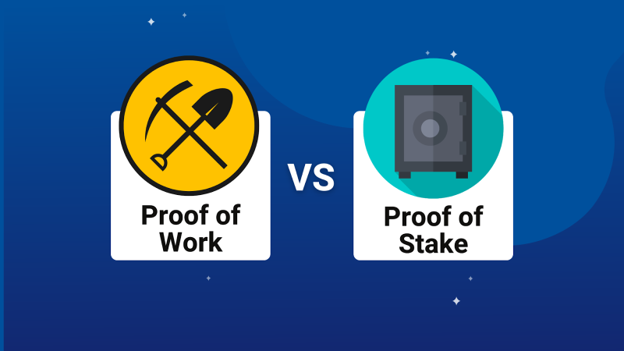Proof-of-Stake vs. Proof-of-Work – Beginner’s Guide

There are two prominent consensus algorithms In blockchain technology: Proof-of-Stake (PoS) vs. Proof-of-Work (PoW). These mechanisms play a pivotal role in maintaining the security and integrity of decentralized networks. In this comprehensive comparison, we will delve into the essence of PoS and PoW, exploring their inner workings and the unique advantages and disadvantages each offer.
And we explain everything in simple English – no technical jargon – for beginners.
Proof-of-Stake vs. Proof-of-Work – The Short Version
Here’s a detailed summary of our guide.
- Proof-of-Work relies on miners solving cryptographic puzzles to validate transactions.
- Proof-of-Stake uses validators who stake coins as collateral to propose and validate blocks.
- PoW is secure but energy-intensive, while PoS is more energy-efficient and promotes decentralization.
- Major blockchain networks like Bitcoin and Litecoin use PoW, while Ethereum switched to PoS in 2022. Other networks, such as Cardano and Tron, already operate on PoS.
- PoW and PoS have unique advantages and disadvantages, and the choice of consensus algorithm depends on specific network goals and requirements.
What Is Proof-of-Work (PoW)
Proof-of-Work is the pioneering consensus algorithm, most notably used by Bitcoin. In this system, miners compete to solve complex cryptographic puzzles to validate and add transactions to the blockchain. The first miner to find the correct solution gets the right to add the new block and earns newly minted cryptocurrency and transaction fees as a reward.
This process is energy-intensive and requires substantial computational power, which is why it often receives criticism for its environmental impact.
How PoW Works
Read the below steps to fully understand how the PoW works.
- Mining: Miners collect pending transactions and compete to solve a cryptographic puzzle, known as the “hash puzzle,” by repeatedly hashing the block’s data until finding a solution.
- Difficulty adjustment: The network adjusts the puzzle’s difficulty periodically to ensure that new blocks are mined consistently, typically every 10 minutes in the case of Bitcoin.
- Consensus: Once a miner discovers the correct solution, the new block is broadcasted to the network, and other nodes verify its validity based on the consensus rules.
Pros
- Security: PoW is highly secure due to the immense computational power required to alter any transaction history. The cost of attacking the network far outweighs the potential gains, making it highly resistant to attacks.
- Proven track record: PoW has been successfully powering the Bitcoin network for over a decade, proving its robustness and reliability.
Cons
- Energy consumption: The energy-intensive nature of PoW consumes vast amounts of electricity, leading to environmental concerns and scalability challenges.
- Centralization: PoW may lead to the concentration of mining power in the hands of a few powerful mining pools. It raises concerns about centralization and potential control over the network.
Proof of work is the only consensus algorithm that has had its security battle-tested at scale and safely stored over $1 trillion in value, in the case of Bitcoin.
Garrick Hileman, head of research at Blockchain.com, speaking to Business Insider
What Is Proof-of-Stake (PoS)
Proof-of-Stake is an alternative consensus mechanism that addresses some of the drawbacks of PoW. Instead of relying on miners, PoS relies on hand-picked validators to create new blocks based on the number of coins they “stake” or lock up as collateral. PoS encourages validators to act honestly. Otherwise, they risk losing their staked coins if they attempt to attack the network.
Here’s how PoS works:
- Staking: Validators lock up a certain number of coins as collateral to become eligible to propose and validate blocks. The more tokens they stake, the higher the chance of being selected as a validator.
- Block proposals: Validators take turns proposing new blocks, and the chance of selection is proportional to the number of coins they have staked.
- Consensus: Validators collectively agree on the validity of new blocks, and malicious behavior leads to the risk of losing staked coins.
Pros
- Energy efficiency: PoS requires significantly less energy than PoW, as there’s no need for computationally intense puzzle-solving.
- Decentralization: PoS promotes decentralization by allowing more participants to become validators without expensive mining equipment.
- Security: The risk of losing staked coins discourages malicious behavior, making PoS secure against attacks.
Cons
- Initial distribution: PoS systems may face challenges in achieving an equitable distribution of coins initially. Thus, it could lead to centralization if a few entities accumulate significant stakes. After all, there aren’t limits on how much validator could stake per crypto.
- Long-term incentives: Critics argue that PoS might incentivize validators to prioritize their own interests rather than the network’s well-being over time.
Proof of stake was developed in response to the high computational costs of proof of work protocols.
Catherine Mulligan, professor at the University of Lisbon’s Instituto Superior Técnico, speaking to Business Insider
FAQs – Proof-of-Stake vs. Proof-of-Work
Discover more information about PoW and PoS.
Which blockchain networks use Proof-of-Work or Proof-of-Stake?
Bitcoin and Litecoin use PoW, while Ethereum is transitioning to a PoS system with Ethereum 2.0. Other networks like Cardano and Tron already operate on PoS.
Which consensus algorithm is more secure?
Both PoW and PoS are secure, but PoW’s long-proven track record may provide a slight edge in terms of established security.
Is PoS truly more energy-efficient?
PoS requires significantly less energy than PoW, making it a greener alternative.
How does PoS handle malicious behavior among validators?
In PoS, validators risk losing their staked coins if they act maliciously, thus incentivizing them to behave honestly and ensuring the network’s security.
Can someone with significant coins control the network in a PoS system?
More coins increases the chances of being selected as a validator. However, most PoS protocols implement coin age or randomization measures to prevent a single entity from dominating the network and promote decentralization.
Final Words on Proof-of-Stake vs. Proof-of-Work
Proof-of-Work and Proof-of-Stake are distinct consensus algorithms with unique advantages and disadvantages. PoW has proven its security and resilience over the years but faces concerns about energy consumption and centralization.
On the other hand, PoS offers a more energy-efficient and decentralized approach but requires careful consideration of initial coin distribution and long-term incentives.
As blockchain technology evolves, the choice between PoW and PoS will depend on individual blockchain networks’ specific needs and goals.





